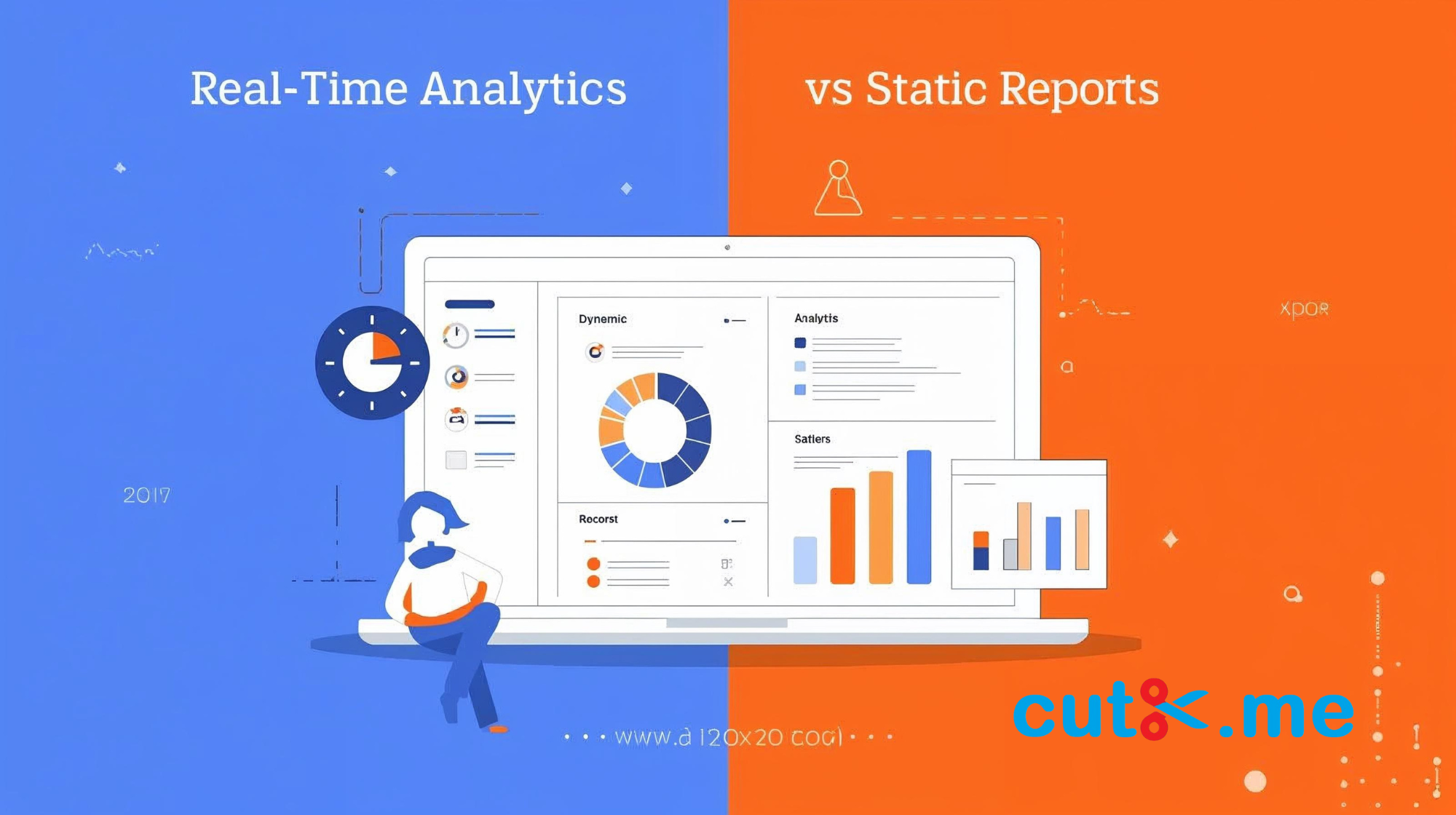
Introduction
Teams now use real time analytics marketing to act on signals as they appear. Static reports show history. Live data shows what happens now. Marketers react to trends faster, stop losing campaigns, and optimize offers in the moment. This guide compares live analytics and static reporting. It gives practical steps to build a hybrid, reliable stack.
Why Real-Time Matters
Real time analytics marketing gives speed. You see user events, campaign clicks, and conversion flows immediately. That speed lets you pause failing ads, highlight winning creatives, or alter bids during a sale. Real-time insight turns a missed opportunity into extra conversions by enabling immediate, measurable responses.
What Static Reports Offer
Static reports give audited results and historical context. Analysts use them for budgeting, forecasting, and executive summaries. These reports contain cleansed data and reconciled figures. Teams trust static numbers for finance and long-term planning. Yet static reports lack the immediacy of live systems, so they cannot support minute-by-minute optimization.
Data Freshness & Decision Speed
Fresh data improves decision speed. With real time analytics marketing you see funnel changes and user friction now. You can test variations quickly and learn fast. Conversely, static snapshots show patterns across days or weeks. Use live feeds for operations and snapshots for strategy to get the best of both worlds.
Infrastructure Needs
Live systems need low-latency pipelines, message queues, and fast stores. Engineering must handle stream processing and failure modes. Static reporting runs on batch ETL and data warehouses. Building a hybrid stack requires connectors from streaming layers into your warehouse for reconciliation.
Accuracy and Trust
Real streams can be noisy. Teams adopt validation steps and reconciliations. Use live signals for immediate actions and compare them to audited daily jobs. That process keeps trust high and prevents bad decisions from unvalidated spikes.
Live Use Cases
Real time analytics marketing fits flash sales, live events, fraud detection, and personalization. It helps adjust bids and personalize offers on the fly. In those scenarios, immediate insight directly lifts revenue and user experience.
Static Use Cases
Static reports support attribution studies, financial reconciliations, and long-run cohort analysis. They show seasonality and benchmark performance across quarters. For strategic investments, static numbers remain critical.
Blending Approaches
Blend live events with nightly batch reconciliation. Stream events into a staging store and push aggregated, validated metrics into your warehouse. This hybrid keeps the operation nimble and the reports tight.
Attribution & Measurement
Real-time attribution can misattribute incomplete sessions. Static attribution uses complete session data. Use early signals to prioritize investigations and static proofs to finalize accounting and budgets.
Cost and ROI
Streaming platforms cost more at first. Yet faster actions reduce wasted spend and recover lost revenue. Start with high-value flows, measure incremental revenue, and expand when ROI appears.
Privacy & Compliance
Follow consent rules and anonymize identifiers. Real-time streams must respect privacy settings. Static reports can store aggregated, compliant metrics for audits. Combine both to remain safe and useful.
Alerting & Ops
Real systems support immediate alerts for anomalies and conversion drops. Ops teams handle incidents faster. Static reports cannot trigger instant operations, so teams must rely on live alerting for urgent issues.
Testing & Experimentation
Run experiments with live observability to detect early lifts. Confirm results in static reports later. This two-step approach helps reduce false positives and ensures robust decision-making.
Visualization & Dashboards
Design dashboards that balance speed and clarity. Show real counters for live ops and trend lines for strategy. Avoid clutter and focus on action-oriented metrics that teams can act on quickly.
Scaling Patterns
Scale real-time pipelines with partitioning and backpressure controls. Scale storage with partitioned warehouses. Monitor costs and throughput carefully as you grow.
Tooling Choices
Pick vendors that support streaming ingestion and warehousing connectors. Look for tooling that makes it easy to route events from the frontend to both the live dashboard and the data lake.
Team Roles & Skills
Hire engineers for streaming pipelines, analysts for data quality, and product folks who respond to live signals. Invest in training so teams use both live and static insights well.
Common Pitfalls
Do not rely only on live data. Validate signals, document pipelines, and avoid premature rollouts. Maintain an audit path so finance and leadership trust your reports.
Implementation Checklist
Start small: instrument one campaign, stream events, build a light dashboard, then add reconciliation jobs. Add monitoring, alerting, and ownership as you scale.
Case Snapshot
A retailer used real time analytics marketing to adjust pricing during a flash event and captured immediate uplift. Static reports later confirmed revenue and helped plan next campaigns.
Future Trends
Expect edge processing, privacy-preserving analytics, and better standards for streaming-warehouse interoperability. These advances will make real time analytics marketing more accessible and compliant.
Conclusion
Real time analytics marketing gives operational speed. Static reports give audited truth and strategic depth. Build a hybrid stack, validate live signals, and teach teams to act with care. That balance drives smarter marketing and sustainable growth.
Frequently Asked Questions
Q1: How quickly can we trust live data?
Trust live data after you add basic validation and reconciliation steps. Use it for rapid signals, then confirm with nightly aggregates.
Q2: Do live systems break budgets?
They can if unchecked. Add guardrails, cost alerts, and budget caps to prevent runaway spend from automated changes.
Q3: Can you run both systems on a small team?
Yes. Start with a single high-value pipeline, use managed tools, and expand as ROI appears.
Q4: Does real-time replace analytics teams?
No. Real-time changes tasks, not roles. Analysts still validate data and build strategic reports.
Q5: What metrics should we prioritize?
Prioritize conversion rate, revenue per session, and retention. Use live metrics for actionable ops and static metrics for planning.
Internal links: CutX.me Features | CutX.me Analytics | CutX.me Pricing | CutX.me Developers | Contact CutX.me




